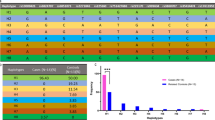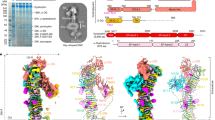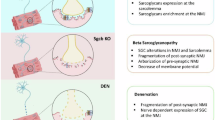Abstract
To define the spectrum of mutations in α-, β-, γ-, and δ-sarcoglycan (SG) genes, we analyzed these genes in 69 probands with clinical and biological criteria compatible with the diagnosis of autosomal recessive limb-girdle muscular dystrophy. For 48 patients, muscle biopsies were available and multiplex western blot analysis of muscle proteins showed significant abnormalities of α- and γ-SG. Our diagnostic strategy includes multiplex western blot, sequencing of SG genes, multiplex quantitative-fluorescent PCR and RT-PCR analyses. Mutations were detected in 57 patients and homozygous or compound heterozygous mutations were identified in 75% (36/48) of the patients with abnormal western blot, and in 52% (11/21) of the patients without muscle biopsy. Involvement of α-SG was demonstrated in 55.3% of cases (26/47), whereas γ- and β-SG were implicated in 25.5% (12/47) and in 17% (8/47) of cases, respectively. Interestingly, we identified 25 novel mutations, and a significant proportion of these mutations correspond to deletions (identified in 14 patients) of complete exon(s) of α- or γ-SG genes, and partial duplications (identified in 5 patients) of exon 1 of β-SG gene. This study highlights the high frequency of exonic deletions of α- and γ-SG genes, as well as the presence of a hotspot of duplications affecting exon 1 of the β-SG gene. In addition, protein analysis by multiplex western blot in combination with mutation screening and genotyping results allowed to propose a comprehensive and efficient diagnostic strategy and strongly suggested the implication of additional genes, yet to be identified, in sarcoglycanopathy-like disorders.
Similar content being viewed by others
Log in or create a free account to read this content
Gain free access to this article, as well as selected content from this journal and more on nature.com
or
References
Lim LE, Campbell KP : The sarcoglycan complex in limb-girdle muscular dystrophy. Curr Opin Neurol 1998; 11: 443–452.
Ervasti JM, Campbell KP : Membrane organization of the dystrophin–glycoprotein complex. Cell 1991; 66: 1121–1131.
Cohn RD, Campbell KP : Molecular basis of muscular dystrophies. Muscle Nerve 2000; 23: 1456–1471.
Rando TA : The dystrophin–glycoprotein complex, cellular signaling, and the regulation of cell survival in the muscular dystrophies. Muscle Nerve 2001; 24: 1575–1594.
McNally EM, Yoshida M, Mizuno Y, Ozawa E, Kunkel LM : Human adhalin is alternatively spliced and the gene is located on chromosome 17q21. Proc Natl Acad Sci USA 1994; 91: 9690–9694.
Azibi K, Bachner L, Beckmann JS et al: Severe childhood autosomal recessive muscular dystrophy with the deficiency of the 50 kDa dystrophin-associated glycoprotein maps to chromosome 13q12. Hum Mol Genet 1993; 2: 1423–1428.
Bonnemann CG, Modi R, Noguchi S et al: Beta-sarcoglycan (A3b) mutations cause autosomal recessive muscular dystrophy with loss of the sarcoglycan complex. Nat Genet 1995; 11: 266–273.
Lim LE, Duclos F, Broux O et al: Beta-sarcoglycan: characterization and role in limb-girdle muscular dystrophy linked to 4q12. Nat Genet 1995; 11: 257–265.
Noguchi S, McNally EM, Ben Othmane K et al: Mutations in the dystrophin-associated protein gamma-sarcoglycan in chromosome 13 muscular dystrophy. Science 1995; 270: 819–822.
Nigro V, Piluso G, Belsito A et al: Identification of a novel sarcoglycan gene at 5q33 encoding a sarcolemmal 35 kDa glycoprotein. Hum Mol Genet 1996; 5: 1179–1186.
Nigro V, de Sa Moreira E, Piluso G et al: Autosomal recessive limb-girdle muscular dystrophy, LGMD2F, is caused by a mutation in the delta-sarcoglycan gene. Nat Genet 1996; 14: 195–198.
Roberds SL, Leturcq F, Allamand V et al: Missense mutations in the adhalin gene linked to autosomal recessive muscular dystrophy. Cell 1994; 78: 625–633.
Moreira ES, Vainzof M, Suzuki OT, Pavanello RC, Zatz M, Passos-Bueno MR : Genotype–phenotype correlations in 35 Brazilian families with sarcoglycanopathies including the description of three novel mutations. J Med Genet 2003; 40: E12.
Ben Othmane K, Speer MC, Stauffer J et al: Evidence for linkage disequilibrium in chromosome 13-linked Duchenne-like muscular dystrophy (LGMD2C). Am J Hum Genet 1995; 57: 732–734.
Piccolo F, Jeanpierre M, Leturcq F et al: A founder mutation in the gamma-sarcoglycan gene of gypsies possibly predating their migration out of India. Hum Mol Genet 1996; 5: 2019–2022.
Carrie A, Piccolo F, Leturcq F et al: Mutational diversity and hot spots in the alpha-sarcoglycan gene in autosomal recessive muscular dystrophy (LGMD2D). J Med Genet 1997; 34: 470–475.
Bushby KM : The limb-girdle muscular dystrophies: diagnostic guidelines. Eur J Paediatr Neurol 1999; 3: 53–58.
Bushby KM : The limb-girdle muscular dystrophies – multiple genes, multiple mechanisms. Hum Mol Genet 1999; 8: 1875–1882.
Bushby KM : Making sense of the limb-girdle muscular dystrophies. Brain 1999; 122 (Pt 8): 1403–1420.
Comerlato EA, Scola RH, Werneck LC : Limb-girdle muscular dystrophy: an immunohistochemical diagnostic approach. Arq Neuropsiquiatr 2005; 63: 235–245.
Politano L, Nigro V, Passamano L et al: Evaluation of cardiac and respiratory involvement in sarcoglycanopathies. Neuromuscul Disord 2001; 11: 178–185.
van der Kooi AJ, de Voogt WG, Barth PG et al: The heart in limb girdle muscular dystrophy. Heart 1998; 79: 73–77.
Yamada H, Saito F, Fukuta-Ohi H et al: Processing of beta-dystroglycan by matrix metalloproteinase disrupts the link between the extracellular matrix and cell membrane via the dystroglycan complex. Hum Mol Genet 2001; 10: 1563–1569.
Anderson LV : Optimized protein diagnosis in the autosomal recessive limb-girdle muscular dystrophies. Neuromuscul Disord 1996; 6: 443–446.
Boito C, Fanin M, Siciliano G, Angelini C, Pegoraro E : Novel sarcoglycan gene mutations in a large cohort of Italian patients. J Med Genet 2003; 40: e67.
Anderson LV, Davison K : Multiplex western blotting system for the analysis of muscular dystrophy proteins. Am J Pathol 1999; 154: 1017–1022.
Deburgrave N, Daoud F, Llense S et al: Protein- and mRNA-based phenotype–genotype correlations in DMD/BMD with point mutations and molecular basis for BMD with nonsense and frameshift mutations in the DMD gene. Hum Mutat 2007; 28: 183–195.
Yau SC, Bobrow M, Mathew CG, Abbs SJ : Accurate diagnosis of carriers of deletions and duplications in Duchenne/Becker muscular dystrophy by fluorescent dosage analysis. J Med Genet 1996; 33: 550–558.
Hentze MW, Kulozik AE : A perfect message: RNA surveillance and nonsense-mediated decay. Cell 1999; 96: 307–310.
Wagner E, Lykke-Andersen J : mRNA surveillance: the perfect persist. J Cell Sci 2002; 115: 3033–3038.
Fanin M, Melacini P, Boito C, Pegoraro E, Angelini C : LGMD2E patients risk developing dilated cardiomyopathy. Neuromuscul Disord 2003; 13: 303–309.
Bonnemann CG, Wong J, Jones KJ et al: Primary gamma-sarcoglycanopathy (LGMD 2C): broadening of the mutational spectrum guided by the immunohistochemical profile. Neuromuscul Disord 2002; 12: 273–280.
Nowak KJ, Walsh P, Jacob RL et al: Severe gamma-sarcoglycanopathy caused by a novel missense mutation and a large deletion. Neuromuscul Disord 2000; 10: 100–107.
Duggan DJ, Hoffman EP : Autosomal recessive muscular dystrophy and mutations of the sarcoglycan complex. Neuromuscul Disord 1996; 6: 475–482.
Vainzof M, Passos-Bueno MR, Pavanello RC, Marie SK, Oliveira AS, Zatz M : Sarcoglycanopathies are responsible for 68% of severe autosomal recessive limb-girdle muscular dystrophy in the Brazilian population. J Neurol Sci 1999; 164: 44–49.
White SJ, Uitte de Willige S, Verbove D et al: Sarcoglycanopathies and the risk of undetected deletion alleles in diagnosis. Hum Mutat 2005; 26: 59.
Duncan DR, Kang PB, Rabbat JC et al: A novel mutation in two families with limb-girdle muscular dystrophy type 2C. Neurology 2006; 67: 167–169.
Tsubata S, Bowles KR, Vatta M et al: Mutations in the human delta-sarcoglycan gene in familial and sporadic dilated cardiomyopathy. J Clin Invest 2000; 106: 655–662.
Acknowledgements
We express our thanks for the patients and families for their participation in the study, and the physicians for referring patients to our diagnostic laboratory. We also thank all members of the laboratoire de Biochimie Génétique et Moléculaire, and the Cell Bank of Cochin Hospital for their technical help. This study was supported by grants from AP-HP, INSERM, FRM and AFM.
Author information
Authors and Affiliations
Corresponding author
Additional information
Supplementary Information accompanies the paper on European Journal of Human Genetics website (http://www.nature.com/ejhg)
Rights and permissions
About this article
Cite this article
Trabelsi, M., Kavian, N., Daoud, F. et al. Revised spectrum of mutations in sarcoglycanopathies. Eur J Hum Genet 16, 793–803 (2008). https://doi.org/10.1038/ejhg.2008.9
Received:
Revised:
Accepted:
Published:
Issue date:
DOI: https://doi.org/10.1038/ejhg.2008.9
Keywords
This article is cited by
-
Genotype–phenotype correlations in alpha-sarcoglycanopathy: a systematic review
Irish Journal of Medical Science (1971 -) (2022)
-
Clinical, genetic profile and disease progression of sarcoglycanopathies in a large cohort from India: high prevalence of SGCB c.544A > C
neurogenetics (2022)
-
Clinical and genetic spectrum of sarcoglycanopathies in a large cohort of Chinese patients
Orphanet Journal of Rare Diseases (2019)
-
Identification of thiostrepton as a pharmacological approach to rescue misfolded alpha-sarcoglycan mutant proteins from degradation
Scientific Reports (2019)
-
Exome sequencing reveals independent SGCD deletions causing limb girdle muscular dystrophy in Boston terriers
Skeletal Muscle (2017)



